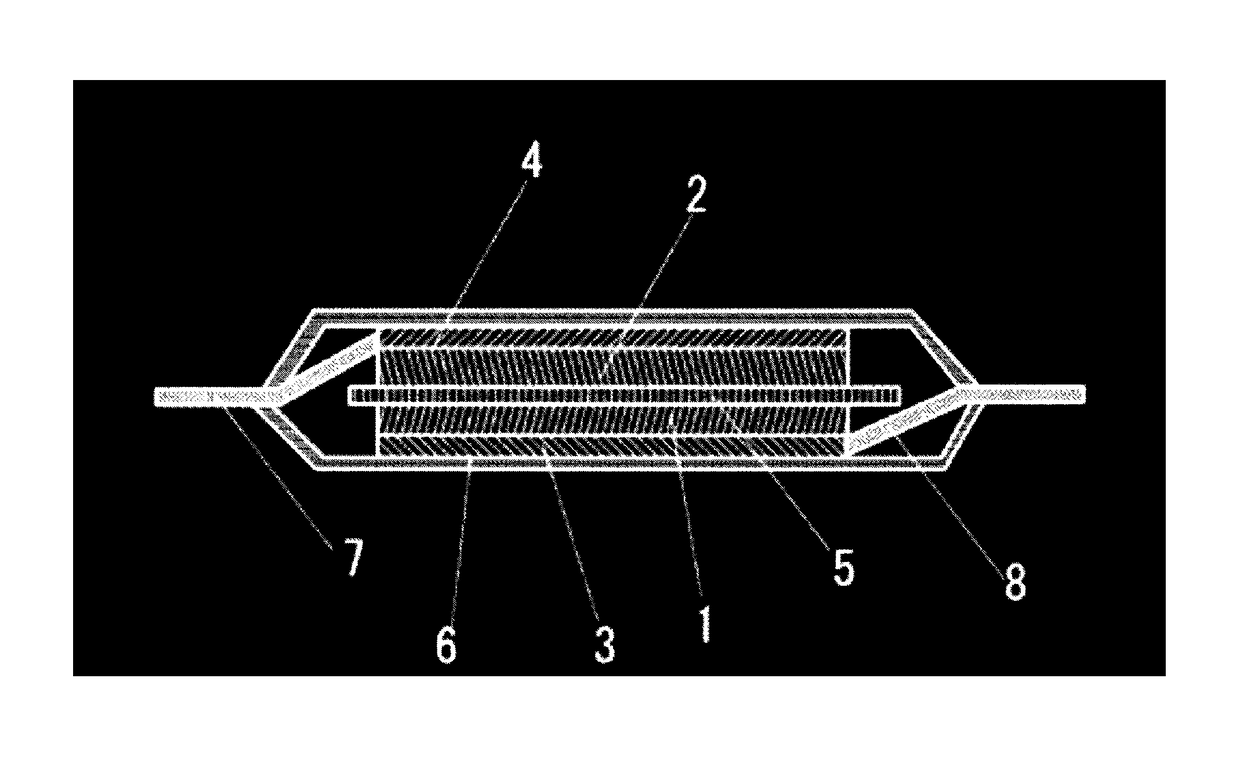Lithium secondary battery
a secondary battery and lithium technology, applied in the direction of positive electrodes, cell components, electrochemical generators, etc., can solve the problems of reduced capacity, gas generation, and improved safety, and achieve excellent long-term cycle characteristics and effective suppression of electrolyte solution
- Summary
- Abstract
- Description
- Claims
- Application Information
AI Technical Summary
Benefits of technology
Problems solved by technology
Method used
Image
Examples
example 1
[0106](Preparation of Positive Electrode)
[0107]Firstly, powders of MnO2, NiO, Li2CO3, and TiO2 were used, and the powders were weighed out for the target composition ratio, and pulverized and mixed. And then, the mixed powder was calcined at 750° C. for 8 hours to prepare LiNi0.5Mn1.37Ti0.13O4. It was confirmed that the positive electrode active material had a nearly single-phase spinel structure. The prepared positive electrode active material and carbon black as a conductivity-imparting agent were mixed, and the mixture was dispersed in a solution in which polyvinylidene fluoride (PVDF) as a binder was dissolved in N-methylpyrrolidone, to prepare a positive electrode slurry. The mass ratio of the positive electrode active material, the conductivity-imparting agent, and the positive electrode binder was 91 / 5 / 4. The positive electrode slurry was uniformly applied on both surfaces of a current collector made of Al. And then, the positive electrode slurry was dried in vacuum for 12 ho...
examples 14 to 18
[0126]Secondary batteries were prepared and the evaluations were conducted in the same manner as in Example 1 except that the compositions of the solvents of the electrolyte solutions were changed to the compositions as shown in Table 2, using the dimeric phosphate compounds represented by the formula (A), and the following formulas (B), (C), and (D). The results are shown in Table 2. The composition ratio (a / b / c / d) in Table 2 is expressed as a volume ratio.
[0127]
[0128]As in Examples 14 to 18, the good cycle characteristic and the effect of reducing the gas generation were achieved when the kind of the dimeric phosphate compound was changed or when two or more kinds of dimeric phosphate compounds were mixed.
[0129]
TABLE 2Solvent in non-aqueous electrolyte solution45° C., 500 cycleDimericFluorinatedCapacityGasPhosphatephosphateetherCarbonateretentiongenerationcompoundcompoundcompoundcompoundratioamount(a)(b)(c)(d)a / b / c / d(%)(cc)Example 14PTTFE(B)FE1EC1.7 / 0.3 / 5 / 3600.22Example 15PTTFE(C)...
examples 19 to 21
[0130]Secondary batteries were prepared and the evaluations were conducted in the same manner as in Example 1 except that the compositions of the solvents of the electrolyte solutions were changed to the compositions as shown in Table 3. The results are shown in Table 3. The composition ratio (a / b / c / d) in Table 3 is expressed as a volume ratio. Additionally, the abbreviations in Table 3 for compounds other than the above-described compounds are as follows.[0131]PTTFP: tris(2,2,3,3-tetrafluoropropyl)phosphate[0132]PTPFP: tris(2,2,3,3,3-pentafluoropropyl)phosphate
[0133]As in Examples 19 to 21, the good cycle characteristic and the effect of reducing the gas generation were achieved when the kind of the fluorinated phosphate compound was changed.
[0134]
TABLE 3Solvent in non-aqueous electrolyte solution45° C., 500 cycleDimericFluorinatedCapacityGasPhosphatephosphateetherCarbonateretentiongenerationcompoundcompoundcompoundcompoundratioamount(a)(b)(c)(d)a / b / c / d(%)(cc)Example 19PTTFP(A)FE1E...
PUM
| Property | Measurement | Unit |
|---|---|---|
| vol % | aaaaa | aaaaa |
| temperature | aaaaa | aaaaa |
| electric potential | aaaaa | aaaaa |
Abstract
Description
Claims
Application Information
 Login to View More
Login to View More - R&D
- Intellectual Property
- Life Sciences
- Materials
- Tech Scout
- Unparalleled Data Quality
- Higher Quality Content
- 60% Fewer Hallucinations
Browse by: Latest US Patents, China's latest patents, Technical Efficacy Thesaurus, Application Domain, Technology Topic, Popular Technical Reports.
© 2025 PatSnap. All rights reserved.Legal|Privacy policy|Modern Slavery Act Transparency Statement|Sitemap|About US| Contact US: help@patsnap.com



